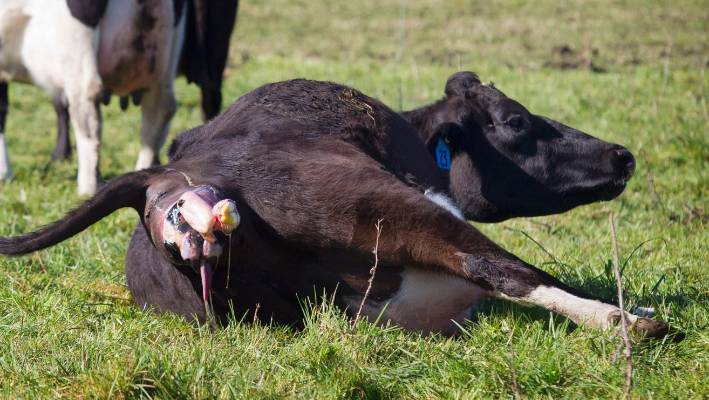

When you are expecting calves, you should start monitoring your mama cows. If you are keeping an eye on them, you will know when labor starts, so if the birthing goes on too long, you can help the cow or call the vet. Not helping a cow in a timely manner can kill the calf. Additionally, when labor goes on longer than it should, it takes longer for a cow’s reproductive tract to recover. This means that it will be longer before she cycles and is able to be breed back. However, for most cows, birthing is a fairly straightforward process.
Know the signs of early labor so you can keep tabs on how long the birth is taking.
1. Not eating, and isolation
In early labor, your cow will stop eating, and she will find a quiet spot away from the herd where she can give birth. At this point, her cervix will begin to relax, and she will be experiencing some contractions. The contractions will last several seconds and occur every ten or twelve minutes. The calf will be getting into position in the mother cow’s womb. For a normal, uncomplicated birth, he will need to be facing toward her vagina with both front legs extended.
2. Restlessness, discomfort
As the contractions intensify in duration, strength and frequency, your cow may seem more and more uncomfortable. She may pace the fence, get up and down and kick at her belly. Between contractions, she may seem perfectly normal, grazing and chewing her cud. In early labor, your cow will also become more alert for predators. She may be more aggressive toward other cows that approach her, and she will run off the farm dog that she’s never minded in the past. Be careful when approaching a cow in labor. She may act out of character, so be alert and ready to move quickly if she seems aggravated at you.
3. Straining
Toward the end of the first stage of labor, your cow will begin to strain a bit. The calf and the water bag are creating a tremendous amount of pressure on the cervix with each contraction. She may urinate and defecate more frequently, which gives the calf more space to pass through the birth canal. She may walk around with her tail held up as she strains. Toward the end of the first stage of labor, the cervix will be almost completely open.
4. Breaking of water
The first stage of labor is over when the “water bag” that has surrounded the calf for nine months ruptures or begins to protrude from the vagina. Sometimes this bag stays intact, but other times it will rupture in a flood of honey-colored liquid. After this point, the cow is said to be in active labor. However, don’t wait for the water to break before you start timing labor. Sometimes the water bag is delivered intact along with the calf. If you see any part of the calf, you can be assured that the cow is in active labor.
Keep track of your cows that are in labor. Even early labor can hurt the calf or cow if it goes on too long. You should be concerned if your cow is off by herself for more than six or eight hours; if she’s repeatedly straining and seems to be making no progress for several hours; if the bottom of the calf’s feet are pointing up rather than down (breech); if you can only see one foot; or if labor seems to have stopped altogether. Don’t risk losing a valuable animal by not knowing what labor looks like.
 Contact Jaguza Support
Contact Jaguza Support